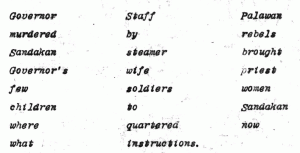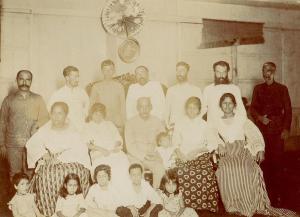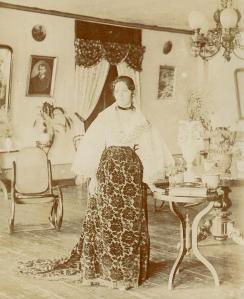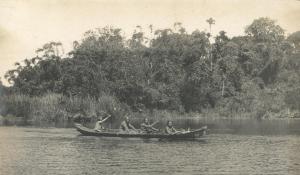A few days ago I wrote about the technology of “wireless telegraphy” and its use in areas of Southeast Asia under colonial rule in the early twentieth century.
Today I was looking at some telegrams that were sent over actual telegraph wires that had been laid down in the nineteenth century. By the end of the nineteenth century, there was a telegraph line that connected Singapore to Hong Kong, and which passed through the British-controlled island of Labuan off the north coast of Borneo.
There was also a telegraph line that connected Manila to Hong Kong, and one that connected Sandakan, the capital of British North Borneo, to the island of Labuan.
In other words, Singapore, Labuan, Sandakan and Manila (via Hong Kong) were all connected by a web of telegraph lines. And in early 1899 there were some messages that went back and forth over these lines concerning some Spanish refugees in Borneo.
On the 23rd of January, 1899 US Consul General in Singapore E. Spencer Pratt received the following telegram from the British governor of Labuan:
“Governor Staff Palawan murdered by rebels Sandakan steamer brought Governor’s wife priest few soldiers women children to Sandakan where quartered now what instructions.”
Palawan is an island in the Sulu archipelago. It had previously been part of Spain’s colonial empire in the region, but late in 1898, Spain’s possessions in the region came under American control.
Since what had once belonged to Spain now belonged to the US, the British official in Labuan contacted the US consulate in Singapore to inquire what to do about refugees who had fled from Palawan to Sandakan in British North Borneo. And since the only telegraph line from Sandakan went to Labuan, an official there must have first contacted fellow British officials in Labuan.
In any case, Consul General Pratt didn’t know what to do, so he sent a telegram on the same day to General Elwell Stephen Otis, the American military governor of the Philippines.
Pratt’s telegram to Otis was as follows:
“Governor Labuan telegraphs Governor staff Palawan murdered steamer brought Governor’s wife other refugees Sandakan where now quartered. Asks instructions. Wire.”
And the next day, Otis responded with the following telegram:
“Murder Governor and staff Palawan reported to Spanish authorities Iloilo two months ago. Your information confirms report.”
The original telegram from the British official in Labuan requested orders for how the refugees should be dealt with. Otis did not provide any. Instead, from his telegraph we see that the governor being referred to was a Spanish governor, and that Spanish authorities had been told of his death two months prior.
Pratt responded the same day with the original question that the British official on Labuan had asked:
“Question Borneo Government is do we or Spain assume maintenance and repatriation refugees.”
These refugees were in a liminal space. They were people who were connected with a Spanish colony that no longer existed. That colony was in the process of being taken over by the US. Meanwhile, the refugees were in a British colony, and the question for the British was who should take responsibility for these people.
Otis responded to Consul General Pratt’s direct question the following day (the 25th) in the following manner:
“Terms of recent treaty not yet communicated no information here.”
Apparently the treaty authorizing the transfer of authority from the Spanish to the US had still not been completed and therefore General Otis did not know what to do about the Spanish refugees. Pratt dutifully passed this information on to Labuan:
“Your telegram requesting instructions Spanish refugees referred Military Governor Manila who replies terms treaty not yet communicated.”
At some point after this, the Spanish Consul in Singapore agreed to take charge of the refugees, for on the 27th a British official notified the US consul general in Singapore that “the Spanish Consul is making the necessary arrangements to repatriate the refugees from Palawan in British North Borneo.”
With that the case seemed to be settled, and it probably was at the governmental level. However, when detailed accounts of this incident finally appeared in the press, it became clear that “the refugees” were a quite diverse group of people.
This is what the Straits Times, for instance, reported on the 18th of February:
“The British North Borneo Herald gives particulars of the massacre of Spaniards at Balabac, an islet in the southern Philippines. The massacre occurred on the 20th November, when the Spaniards were at mass.
“At a given signal the church doors were closed, and ten men were murdered including the Governor, Dr. José Bellamy; Medical Officer, Andres de Castro; 2nd Lieut. of Marines, Juan Fernando; 5th Officer of Public Works, Carlos Larrado; and a Lance Corporal, three Spanish soldiers, and two natives.
“The rising was carefully planned. The leader’s name is given as Carlos Parino, a native of Ilo-ilo, who afterwards proclaimed himself President. About 300 insurgents joined in the insurrection.
“After the massacre, the rebels placed seven Spanish soldiers under arrest. The wife of the Governor, another Spanish lady with four children, a Filipino carpenter with his wife and four children, another Filipino woman named Filimena Bassa with 6 children, the padre, and others were closely guarded in a separate house.
“Early in January, the steamer Labuan, commanded by Captain Pfort, arrived at Balabac. He, by tact, persuasion, and payment of money, managed to secure the release of these captives. He rescued altogether 121 persons, including a number of Chinese and their hangers-on.
“It seems quite certain that the rebels in Balabac are in concert with Aguinaldo. In Palawan, a large islands near Balabac, piracy is again rife.”
So through the interconnected world that telegraph lines had made possible, officials in Sandakan, Labuan, Singapore and Manila were able to communicate almost effortlessly and resolve an “international crisis.”
But when I see who the actual refugees were, I have to wonder what the final resolution of this issue looked like. The Spanish Consul agreed to “repatriate the refugees,” but did he actually “repatriate” ALL of the refugees? Did the Chinese and Filipinos go “home” to Spain? Or were they repatriated to some place else? If so, where?
In reading the telegraph statements, I’m struck by how simple the language is, even though it attempts to convey information about complex events. That was the nature of the technology. It enabled easy communication, but somehow it looks like its simplicity also enabled details to be overlooked.
Somehow I have the feeling that those “Chinese and their hangers-on” probably did not get “repatriated” anywhere.
[The picture of Otis above is from Wikipedia and the other pictures are from the Philippine Photographs Digital Archive at the University of Michigan.]











Really interesting post, especially when I come from Singapore! You can try looking up telegrams during WWI, conveying important and sometimes complex information for orders, coordination, although it is encrypted.
So this means that you’ve seen telegrams like that? Where did you see/find them?
I’m getting this stuff off microfilms that the US National Archives made of consular despatches, but the microfilms end in the early 20th century. They don’t go as far as WW I, although I guess those documents must still be in the national archives.
Hi, fascinating article. Were you able to find any pictures of this elusive consul? I’m recently started a blog on Philippine history (beginning 1898) and am doing a series on posts on the role that Pratt played as self-appointed emmisary between Aguinaldo and Dewey. (see my earlier postings). Later on, his attempts at diplomacy got him cashiered by his government.
Max Rialto
Thanks for the comment! I didn’t know about the Aguinaldo-Dewey-Pratt triangle. That’s very interesting.
I also haven’t made an effort to learn more about Pratt (yet), but from the little I’ve seen, yea, it’s clear that he had energy and probably ambition.